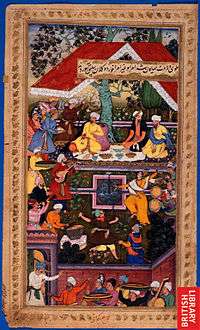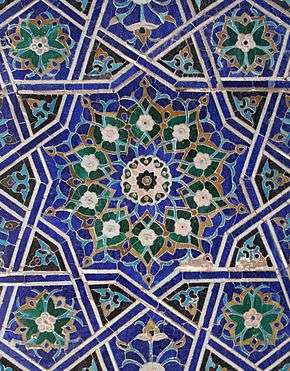Charbagh
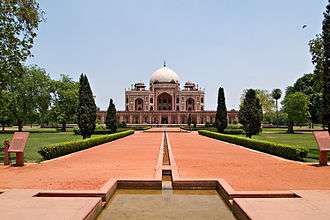
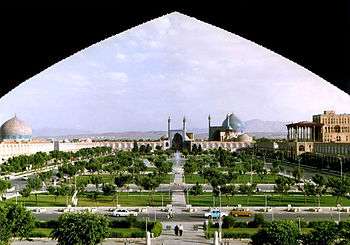
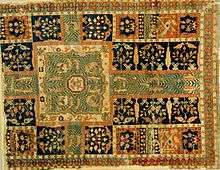
Charbagh or Chahar Bagh (Persian: چهارباغ, chahār bāgh, "Four Bāghs") is a Persian-style garden layout. The quadrilateral garden is divided by walkways or flowing water into four smaller parts.[1] In Persian, "Chār" means 'four' and "bāgh" means 'garden'.
History
One of the hallmarks of Persian gardens is the four-part garden laid out with axial paths that intersect at the garden's centre. This highly structured geometrical scheme, called the chahar bagh, became a powerful metaphor for the organization and domestication of the landscape, itself a symbol of political territory.[2]
The Chahrbagh-e Abbasi (or Charbagh Avenue) in Isfahan, Iran, built by Shah Abbas the Great in 1596, and the garden of the Taj Mahal in India are the most famous examples of this style. In the Charbagh at the Taj Mahal, each of the four parts contains sixteen flower beds.
Chahrbagh originated from the time of Achaemenid Persia. Greek historians, such as Herodotus and Xenophon, give extensive accounts of Cyrus the Great's palatial city of Pasargadae and his four-gardens.[3]
In India, the Char Bagh concept in imperial mausoleums is seen in Humayun's Tomb in Delhi in a monumental scale. Humayan's father was the Central Asian Conqueror Babur who succeeded in laying the basis for the Mughal dynasty in the Indian Subcontinent and became the first Mughal emperor. The tradition of paradise garden originated among the Mughals, originally from Central Asia, which is found at Babur's tomb, Bagh-e Babur, in Kabul.[4]
This tradition gave birth to the Mughal gardens design and displayed its high form in the Taj Mahal — built by Mughal emperor Shah Jahan, the great, great, grandson of the Central Asian Conqueror Babur, as a tomb for his favourite Indian wife Mumtaz Mahal, in Agra, India. Here, unlike most such tombs, the mausoleum is not in the centre of the garden, but on its northern end. The garden features Italian cypress trees (Cupressus sempervirens) that symbolize death. Fruit trees in the garden symbolize life. The garden attracts many birds, which are considered one of the features of the garden.
Contemporary
A charbagh is located on the roof top of the Ismaili Centre in South Kensington, London.[5] The Delegation of the Ismaili Imamat, located on Sussex Drive in the Canadian capital Ottawa, Ontario contains a charbagh in a modern setting. The Ismaili Center and Aga Khan Museum in Toronto features a modern interpretation of a charbagh between the buildings.
References
- ↑ Cornell, Vincent J. (2007) Voices of Islam: Voices of art, beauty, and science (volume 4 in the Voices of Islam series) Praeger, Westport, Connecticut, pages 94-95, ISBN 978-0-275-98735-0
- ↑ D. Fairchild Ruggles, Islamic Gardens and Landscapes, University of Pennsylvania Press, 2008, p.39
- ↑ History of Persian Garden Design
- ↑ Mughul Tomb GardensThe poetics of gardens, by Charles Willard Moore, William J. Mitchell. Published by MIT Press, 2000. ISBN 0-262-63153-9. Page 17.
- ↑ A Place in Paradise - radio coverage from the BBC about the charbagh garden on top of the Ismaili Centre in South Kensington
Further reading
- Lehrman, Jonas Benzion (1980). Earthly paradise: garden and courtyard in Islam. University of California Press. ISBN 0-520-04363-4.
- Ruggles, D. Fairchild (2008). Islamic Gardens and Landscapes. University of Pennsylvania Press. ISBN 0-8122-4025-1.
External links
| Wikimedia Commons has media related to Charbagh. |
- Babur's Garden - video from the Asia Society, US
